Latvian lats
| Latvijas lats (Latvian) | |
|---|---|
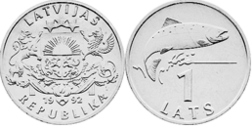 The standard version of the Ls 1 coin depicted a salmon | |
| ISO 4217 | |
| Code | LVL |
| Unit | |
| Plural | lati (nom. pl.) or latu (gen. pl.) |
| Symbol | ℒ︁𝓈 (first lats) Ls (second lats) |
| Denominations | |
| Subunit | |
| 1⁄100 | santīms |
| Plural | |
| santīms | santīmi (nom. pl.) or santīmu (gen. pl.) |
| Symbol | |
| santīms | s |
| Banknotes | |
| Freq. used | Ls 5, Ls 10, Ls 20, Ls 50, Ls 100 |
| Rarely used | Ls 500 |
| Coins | |
| Freq. used | 1 s, 2 s, 5 s, 10 s, 20 s, 50 s, Ls 1, Ls 2 |
| Demographics | |
| Replaced | Latvian ruble (1 LVL = 200 LVR) |
| Replaced by | Euro (1 EUR = 0.702804 LVL) |
| User(s) | None, previously: |
| Issuance | |
| Central bank | Bank of Latvia |
| Website | www |
| Valuation | |
| Inflation | -0.4% |
| Source | ECB,[2] April 2013 |
| EU Exchange Rate Mechanism (ERM) | |
| Since | 2 May 2005[1] |
| Fixed rate since | 1 January 2005 |
| Replaced by euro, non cash | 1 January 2014 |
| Replaced by euro, cash | 15 January 2014[3] |
| 1 € = | Ls 0.702804 (Irrevocable) |
| This infobox shows the latest status before this currency was rendered obsolete. | |
The Latvian lats (plural: lati, plural genitive: latu, second Latvian lats ISO 4217 currency code: LVL) was the currency of Latvia from 1922 until 1940 and from 1993 until it was replaced by the euro on 1 January 2014. A two-week transition period during which the lats was in circulation alongside the euro ended on 14 January 2014.[3] The lats is abbreviated as Ls[4] and was subdivided into 100 santīmi (singular: santīms; from French centime), abbreviated as an s after the santīm amount.[5]
The Latvian lats has been recognized as one of the 99 entries of the Latvian Culture Canon.[6]
First lats, 1922–1940


The first lats (symbol: ℒ︁𝓈) was first introduced on 3 August 1922, replacing the first Latvian ruble at a rate of ℒ︁𝓈 1 = Rbls 50.[7] The lats was pegged against the gold standard from its introduction until 28 September 1936, when it was pegged against the British pound sterling at a rate of 1 £ = 25,22 ℒ︁𝓈.[8][9] However, as the pound still retained the standard, a link of sorts existed until 1940.[10]
On 17 June 1940, Latvia was occupied by the USSR. After the dismantling of the Bank of Latvia and its replacement with the Latvia Republican Office of the Gosbank on 10 October, the Soviet ruble was introduced alongside the lats on 25 November 1940 at par, although the real monetary value of the ruble was about a third of the lats. Thus both wages and prices were gradually raised to devalue the lats from June to November 1940. To lessen the effect of the exodus of goods sent by Soviet occupational personnel to the USSR, taking advantage of the new exchange rate, buyer limits for various goods were introduced.[11]
Although the Soviet authorities initially pledged not to abolish the lats, it was taken out of circulation without prior warning at 13:05 on 25 March 1941, simultaneously nationalising all deposits larger than ℒ︁𝓈 1000. A part of the Latvian gold, silver and currency reserves were sent to Moscow at the start of the occupation.[12][13]
Coins
Coins were issued in denominations of 1, 2, 5, 10, 20 and 50 santīmu, ℒ︁𝓈 1, ℒ︁𝓈 2 and ℒ︁𝓈 5. The 1s, 2s and 5s were in bronze (Cu, Sn, Zn), the 10s, 20s and 50s were nickel, while coins of ℒ︁𝓈 1 and above were struck in silver, with a purity of 83,5 percent.[14]
Banknotes
The Latvian Bank issued notes from 1922 in denominations of ℒ︁𝓈 20, ℒ︁𝓈 25, ℒ︁𝓈 50, ℒ︁𝓈 100 and ℒ︁𝓈 500. They also issued ℒ︁𝓈 10 notes which were 500 ruble notes overprinted with the new denomination. The government issued currency notes from 1925 in denominations of ℒ︁𝓈 5, ℒ︁𝓈 10 and ℒ︁𝓈 20.
Second lats, 1993–2013

The lats was reintroduced on 5 March 1993,[15] replacing the Latvian ruble, which continued to circulate and kept validity until and including 30 June 1994[16] at a rate of LR 200 being equivalent to Ls 1. The Ls 5 banknote was introduced first, and the last banknote to be introduced was the Ls 500 banknote on 20 July 1998.[17] The lats was replaced on 1 January 2014 by the euro, at the rate of Ls 0.702804 to €1. The second lats can be exchanged to euros at the official rate at the Bank of Latvia's cashier's office in Riga.[18]
Until the end of its circulation in January 2014, the lats was the fourth highest-valued currency unit per face value, after the Kuwaiti dinar, Bahraini dinar, and the Omani rial. The Ls 500 note was the world's third most valuable banknote after the $10,000 Brunei/Singaporean dollar note and the 1,000 Swiss franc note.[19] With the abolition of the Maltese lira on 1 January 2008, the lats became the most valued European currency.
Coins
Coins were issued in denominations of 1s, 2s, 5s, 10s, 20s and 50s, Ls 1 and Ls 2. Besides standard coins in the list below and coins for collectors, the following coins were also issued: three commemorative circulation coins were issued in denominations of Ls 2, Ls 10 and Ls 100 (the latter two of which were, respectively, silver and gold), a Ls 100 gold bullion coin, and a series of limited design Ls1 coins twice a year from 2004 to 2013, and once in 2001 and 2003.
The initial standard Ls 2 coin was issued only once in 1992, it was a copper-nickel coin of 6g and measured 24.35mm in diameter.[20] It was gradually replaced in circulation from 1999 with the below bimetallic coin due to counterfeiting issues.[21]
The standard coins were designed by Gunārs Lūsis and Jānis Strupulis.
| Current standard series | ||||||||
|---|---|---|---|---|---|---|---|---|
| Image | Value | Value in euros (€) | Composition | Diameter | Weight | Edge | Issued | Description |

|
1 s | €0.014 | copper-clad iron | 15.65 mm | 1.60 g | Smooth | 1992, 1997, 2003, 2005, 2007, 2008 | Obverse: The small coat of arms of Latvia, inscription LATVIJAS REPUBLIKA and the date of issue. Reverse: denomination, ethnographic sun ornaments joined by five arches symbolizing a day of work. |

|
2 s | €0.028 | copper-clad iron | 17.00 mm | 1.90 g | 1992, 2000, 2006, 2007, 2009 | ||

|
5 s | €0.071 | copper / nickel / zinc alloy | 18.50 mm | 2.50 g | Smooth | 1992, 2006, 2007, 2009 | Obverse: The small coat of arms of Latvia, inscription LATVIJAS REPUBLIKA and the date of issue. Reverse: denomination, ethnographic sun ornaments joined by five arches symbolizing a day of work. |

|
10 s | €0.142 | copper / nickel / zinc alloy | 19.90 mm | 3.25 g | 1992, 2008 | ||

|
20 s | €0.285 | copper / nickel / zinc alloy | 21.50 mm | 4.00 g | 1992, 2007, 2009 | ||

|
50 s | €0.711 | copper / nickel alloy | 18.80 mm | 3.50 g | Reeded | 1992, 2007, 2009 | Obverse: The small coat of arms of Latvia, inscription LATVIJAS REPUBLIKA and the date of issue. Reverse: pine sapling, which symbolizes Latvian forests and the denomination, separated by a horizontal line. Edge: reeded. |

|
Ls 1 | €1.423 | copper / nickel alloy | 21.75 mm | 4.80 g | Plain and lettering: LATVIJAS BANKA ♦ LATVIJAS BANKA ♦ | 1992, 2007, 2008 | Obverse: The large coat of arms of Latvia, inscription LATVIJAS REPUBLIKA and the date of issue. Reverse: leaping salmon, which symbolizes the waters of Latvia, and denomination. |

|
Ls 2 | €2.846 | Inner: copper / nickel / zinc alloy Outer: copper / nickel alloy |
26.30 mm (inner: 18.21 mm) |
9.50 g (inner: 4.50 g, ring: 5.00 g) |
Reeded and lettering: LATVIJAS BANKA ♦ LATVIJAS BANKA ♦ | 1999, 2003, 2009 | Obverse: The large coat of arms of Latvia, and on the ring inscription LATVIJAS REPUBLIKA and the date of issue. Reverse: A cow, which symbolizes the Latvian countryside, and denomination. |
| Relative size of coins | ||||||||
Banknotes
All banknotes are 130 × 65 mm in size. They were printed by Giesecke & Devrient GmbH in Germany and were designed by Imants Žodžiks and Valdis Ošiņš.[22]
| Current Series | |||||||
|---|---|---|---|---|---|---|---|
| Image | Value | Value in euros (€) | Main Colour | Description | |||
| Obverse | Reverse | Obverse | Reverse | ||||
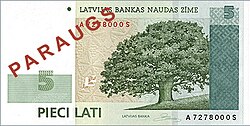
|
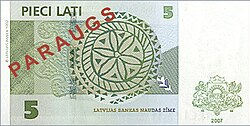
|
Ls 5 | €7.11 | Green | Oak tree, sun ornament background | Woodcarving of a sun on a distaff | |
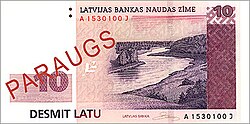
|

|
Ls 10 | €14.23 | Purple | Bends of the River Daugava (Daugavas loki) | Latvian brooch (sakta) | |
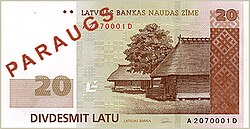
|

|
Ls 20 | €28.46 | Brown | Traditional homestead | Woven linen (dreļļu pattern) | |

|
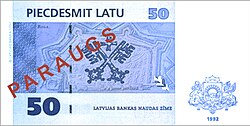
|
Ls 50 | €71.14 | Blue | Sailing-ship | Keys (Historical seal of Riga), Riga fortifications map | |
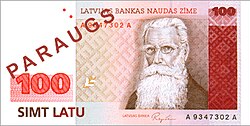
|
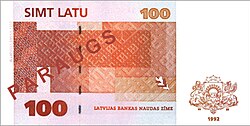
|
Ls 100 | €142.29 | Red | Krišjānis Barons | Lielvārde Belt (Lielvārdes josta) | |
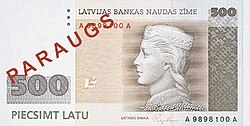
|
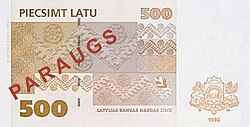
|
Ls 500 | €711.44 | Grey | Latvian folk-maid[note 1] | Ornamental bronze crowns | |
See also
Notes
- ^ Similar to the 1929 silver five lats coin.
References
- ^ "ECB: Euro central rates and compulsory intervention rates in ERM II". European Central Bank. 2 May 2005. Retrieved 9 June 2014.
- ^ "ECB: Inflation and the euro". European Central Bank. Retrieved 9 June 2014.
- ^ a b Eglitis, Aaron (9 July 2013). "Latvia Wins Final EU Approval to Adopt Euro on Jan. 1 Next Year". Bloomberg. Retrieved 9 June 2014.
- ^ "2 lats (Ls 2 in short)". Latvijas Banka. Retrieved 5 November 2022.
- ^ "1 santims (1 s in short)". Latvijas Banka. Retrieved 5 November 2022.
- ^ "Latvian National Currency – the Lats". Latvian Culture Canon. Retrieved 6 May 2020.
- ^ Kristīne Ducmane, Anda Ozoliņa (2013). Naudas Laiki Latvijā (in Latvian). Lauku Avīze. p. 147. ISBN 978-9984-878-84-3.
- ^ "Video: The story of Latvia's "lats" currency". eng.lsm.lv. 11 March 2020. Retrieved 4 December 2023.
- ^ Ducmane, Kristīne. "Sava nauda savā Latvijas Bankā II - LV portāls". lvportals.lv (in Latvian). Retrieved 4 December 2023.
- ^ Lucas, Edward (18 November 2013). "Lat it be". The Economist. Retrieved 8 July 2018.
- ^ "Sava nauda savā Latvijas Bankā IV". lvportals.lv (in Latvian). Retrieved 8 July 2018.
- ^ "History of money in Latvia". eiro.lv. Retrieved 8 July 2018.
- ^ "History of the Bank of Latvia". Bank of Latvia. Archived from the original on 9 February 2021. Retrieved 8 July 2018.
- ^ Kristīne Ducmane, Anda Ozoliņa (2013). Naudas Laiki Latvijā (in Latvian). Lauku Avīze. p. 163. ISBN 978-9984-878-84-3.
- ^ Ēvalds Vēciņš, Dzintars Rubenis, Gunārs Rolands Grīns (2002). Nauda Latvijā XX gadsimtā : Katalogs I daļa 2. sējums (in Latvian). Riga: Zvaigzne. p. 79. ISBN 9984223450. OCLC 45699853.
{cite book}: CS1 maint: multiple names: authors list (link) - ^ Ēvalds Vēciņš, Dzintars Rubenis, Gunārs Rolands Grīns (2002). Nauda Latvijā XX gadsimtā : Katalogs I daļa 2. sējums (in Latvian). Riga: Zvaigzne. p. 81. ISBN 9984223450. OCLC 45699853.
{cite book}: CS1 maint: multiple names: authors list (link) - ^ Ēvalds Vēciņš, Dzintars Rubenis, Gunārs Rolands Grīns (2002). Nauda Latvijā XX gadsimtā : Katalogs I daļa 2. sējums (in Latvian). Riga: Zvaigzne. p. 61. ISBN 9984223450. OCLC 45699853.
{cite book}: CS1 maint: multiple names: authors list (link) - ^ "The Cashier's Office". Bank of Latvia. Retrieved 8 June 2020.
- ^ Karaian, Jason (31 December 2013). "One of the most valuable banknotes in the world is about to vanish". Quartz. Retrieved 9 June 2014.
- ^ 2 Lati
- ^ Divlatniekus ar govs attēlu vairs nedod apgrozībā
- ^ "Banknotes of the Bank of Latvia". Bank of Latvia. Retrieved 2 January 2018.
External links
- Central bank of Latvia
- Coins of Latvia at CISCoins.net
- The pre-euro banknotes of Latvia (in English and German)
- Video: The story of Latvia's "lats" currency. 11 March 2020. Public Broadcasting of Latvia.



